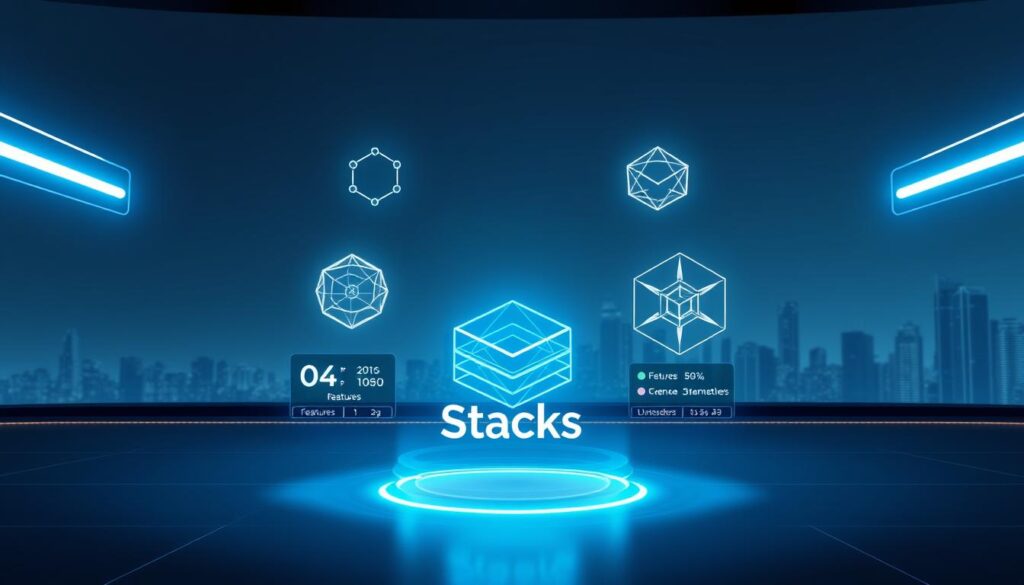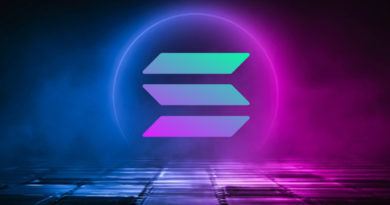Discover the Stacks (STX) Cryptocurrency: Secure, Scalable, Innovative
Imagine a blockchain that combines Bitcoin’s legendary security with the flexibility of smart contracts. Stacks (STX) saw a 520% revenue jump in Q3 2024. This shows its huge growth promise. It’s not just another blockchain—it’s built on top of Bitcoin, using its $13 trillion power to secure transactions.
Launched in 2017 by Muneeb Ali and Ryan Shea, Stacks started as Blockstack. It raised $50 million in its first token sale. Today, its Hiro wallet has been downloaded 40,000 times. Its Clarity language makes smart contracts easy to check and bug-free.
The network’s smart contract growth in 2022 was 20% CAGR. It handled 350 million monthly API requests for DeFi and NFT projects. Stacks’ Proof of Transfer (PoX) lets users earn Bitcoin rewards by locking STX tokens. This boosts security with economic benefits.
Its Nakamoto upgrade made transactions almost instant. In 2019, Stacks was the first crypto to get SEC approval for a $28 million Reg A+ offer in the U.S.
Key Takeaways
- Stacks (STX) uses Bitcoin’s security while enabling smart contracts via its layer-1 blockchain.
- Its 2024 revenue skyrocketed 520%, with STX market cap growing 9% in Q1 2024.
- Clarity language reduces smart contract bugs, backed by 97,000+ Bitcoin username registrations in late 2022.
- Stacks avoids overloading Bitcoin’s blockchain, using microblocks for fast transactions.
- Available on major exchanges like Coinbase and Kraken, STX tokens power DeFi and Web3 apps.
What Is Stacks (STX) Cryptocurrency?
Stacks (STX) started with a dream to take control of the internet away from big companies. It was created in 2013 by Muneeb Ali and Ryan Shea, both from Princeton. They first called it Blockstack PBC.
In 2017, they launched a platform to make the internet truly owned by users. This led to a big win in 2019 when the SEC approved their ICO. This was the first time this had happened, raising $23M.
The Origins of Stacks
In 2021, Blockstack became Stacks and launched Stacks 2.0. This allowed U.S. investors to buy STX for the first time. The network grew, with over 300 apps built by 2018.
It also got a big boost with partnerships like the Stacks Accelerator. They funded CityCoins, helping the ecosystem grow.
Core Philosophy and Mission
“Can’t be evil”
Stacks is all about giving power back to the users. It wants to stop big tech companies from controlling our data. The project is run by a non-profit foundation, focusing on transparency.
The STX Token Explained
- Utility: Enables smart contracts, transaction validation, and digital asset registration via tokenization.
- Regulatory milestone: First SEC-qualified token in 2019.
- Value: As of 2023, STX’s $633M market cap shows its importance in the $1T Bitcoin economy.
STX also helps secure the network through Proof of Transfer consensus. This rewards users for keeping the network safe. It makes fast transactions possible while keeping Bitcoin secure.
The Evolution and History of Stacks
Stacks (STX) started in 2013 with Muneeb Ali and Ryan Shea’s dream of a blockchain on Bitcoin’s security. They raised $47 million in 2017 for a blockchain that would change how apps work.
- 2019: SEC-regulated token sale raised $23M, marking the first such approval for a cryptocurrency.
- 2021: Stacks 2.0 mainnet launched, enabling smart contracts and digital assets on Bitcoin’s infrastructure.
- 2023–2024: Nakamoto upgrade phases aim to cut block times to 4–5 seconds, boosting speed.
By 2021, Stacks grew fast, with Arkadiko (DeFi) and StacksPunks (NFTs) reaching $60M and $1.5M in TVL. Today, it has over 40,000 wallets and 2,500 smart contracts. Its Proof of Transfer (PoX) model links STX to Bitcoin, setting it apart.
The Miami CityCoins project shows Stacks’ real-world value, adding $20M+ to city budgets. STX’s stacking rewards holders with BTC, showing it’s both innovative and compliant. It’s a top choice for Bitcoin-based blockchain solutions.
Understanding the Technology Behind Stacks
Stacks combines new tech with Bitcoin’s strong security. It uses Bitcoin’s blockchain to create a safe space for smart contracts and apps.
Proof of Transfer (PoX) Consensus Mechanism
Stacks merges with Bitcoin using PoX. Miners lock Bitcoin to validate STX blocks, earning rewards. This model links Bitcoin’s security with Stacks’ features.
Bitcoin Integration and Security
Every Stacks transaction is tied to Bitcoin’s blockchain, making it secure. The Nakamoto upgrade makes blocks appear every 1 minute. This keeps Stacks safe without changing Bitcoin’s rules.
Clarity Smart Contract Language
Developers write smart contracts in Clarity. It’s designed to avoid bugs and is easy to read. This makes it simple for auditors to check the code’s safety.
Scalability Solutions
Stacks has a layered design to keep Bitcoin’s core separate from apps. The Nakamoto upgrade increases speed by 3x, allowing for thousands of transactions per second. This setup prevents Bitcoin’s layer from getting too busy while opening up more uses for apps.
By linking to Bitcoin’s blockchain, Stacks stays away from centralization risks. Its tech choices focus on security, speed, and ease of use. These are important for it to be useful in the real world.
Key Features and Benefits of the Stacks Blockchain

Stacks (STX) blockchain combines Bitcoin’s security with new, programmable features. It uses Bitcoin’s network for security, thanks to its 20-year history. This mix makes digital assets on Stacks safe and allows for smart contracts and apps.
- Immutable smart contracts that cannot be altered post-launch
- Clarity language designed to minimize vulnerabilities compared to Solidity
- Proof of Transfer (PoX) consensus that reduces energy use by relying on Bitcoin transactions
| Feature | Benefit |
|---|---|
| Bitcoin-pegged sBTC tokens | Enables seamless BTC use in decentralized finance |
| 6% APY stacking rewards | Passive income for STX holders in BTC |
| 100% Bitcoin finality | Instant transaction confirmation without waiting for block confirmations |
Tools like the Hiro wallet and 40,000+ wallet users show Stacks is used in real life. Its smart contracts are safe, and block times are now seconds. With a $4B market cap and 2,500+ smart contracts, Stacks offers practical solutions for finance and digital assets.
Stacking Rewards: Earning Passive Income with STX
Unlock passive income by joining Stacking rewards on the Stacks blockchain. This lets users lock STX tokens to secure the network. They earn Bitcoin (BTC) as a reward. By doing this, they help the decentralized finance ecosystem and support the Proof of Transfer (PoX) consensus.
How Stacking Works
- Users lock STX tokens for a 2-week cycle (2,100 Bitcoin blocks).
- Locking STX generates points proportional to the tokens held, determining reward shares.
- Rewards are paid in BTC, creating diversification for investors.
Reward Cycles and Earnings
Earnings depend on locked STX volume and network activity. Platforms like StackingDAO offer 6.35% APY, while Xverse Pool provides 6% APY. Yields change based on:
- Market price of BTC and STX
- Total STX locked in the ecosystem
- Participation in solo vs. pooled options
Withdrawals reset the 14-day lock period, impacting continuous earnings.
Requirements for Participation
Options vary to fit different investment sizes:
- Solo Stacking: Minimum 100,000 STX for full control
- Xverse Pool: Start with just 100 STX via pooled participation
- Liquid Stacking: No minimum requirement with instant access to funds
Users must hold STX in compatible wallets like Ledger or Trezor, or use exchanges like OKX for simplified access. Tokenization of STX enables flexible participation through these platforms.
Stacking rewards have tax implications: The IRS classifies BTC earnings as taxable income. Investors should track rewards for accurate reporting.
How Stacks Compares to Other Smart Contract Platforms

When picking a blockchain for smart contracts, you need to think about security, cost, and flexibility. Stacks stands out because it uses Bitcoin’s network. This gives it a unique edge over Ethereum and Solana, with its own set of benefits and drawbacks.
Stacks vs. Ethereum
Ethereum is a big name in smart contracts, but it has its downsides like high fees and downtime. Stacks, on the other hand, uses Clarity language to cut down on coding mistakes. Plus, it’s anchored to Bitcoin for security, making transactions cheaper and safer.
- Security: Stacks uses Bitcoin’s blockchain for security; Ethereum relies on its own Proof of Stake
- Smart contracts: Clarity’s decidable logic vs Ethereum’s Turing-complete Solidity
- Cost: Fixed transaction fees vs Ethereum’s volatile gas prices
Stacks vs. Solana
Solana is fast, handling up to 65k transactions per second, but it’s not as secure as Stacks. Stacks focuses on security, with 50 transactions per second, thanks to Bitcoin’s network. This makes it a reliable choice for important smart contracts.
- Speed: Stacks’ 50 TPS vs Solana’s 65k TPS
- Security: Bitcoin-anchored consensus vs Solana’s validator-based model
- Rewards: Stacks users earn BTC through stacking; Solana rewards are native tokens only
Unique Value Propositions
Stacks is special because it’s tied to Bitcoin. This means developers get to use the most secure blockchain out there. Plus, they can write smart contracts with Clarity, which helps avoid mistakes. With over 400 dApps already on Stacks, it’s clear it’s growing fast. And, unlike others, Stacks rewards users with Bitcoin, making it a great choice for those who value it.
- Decidable smart contract language reducing bugs
- Built-in Bitcoin security without sacrificing functionality
- Fixed STX supply vs inflationary models
Acquiring and Storing Stacks (STX) Tokens
Stacks (STX) tokens can be bought on big cryptocurrency exchanges like Binance, Kraken, and KuCoin. You can trade fiat currencies or other digital assets for STX. Prices are updated in real time. For those who like decentralized options, peer-to-peer platforms also support STX transactions.
Keeping your tokens safe is key. Digital assets like STX need wallets that are both easy to use and secure. Hot wallets, like Xverse, are great for daily use but need careful watching for online threats. For keeping assets safe long-term, cold hardware wallets like Ledger or Trezor are best. Xverse also works as a self-custodial wallet, making it easy to stack—lock STX to earn Bitcoin rewards.
“Security is the foundation of cryptocurrency ownership.”
- Hot wallets: Perfect for short-term use, accessible via apps like Xverse.
- Cold storage: Hardware devices like Trezor protect assets from cyberattacks.
- Stacking: Users can lock 100+ STX to earn 10% APY in BTC, with rewards tied to Bitcoin’s block cycles.
Always back up recovery phrases and use two-factor authentication. Keeping your assets safe is essential for using Stacks’ ecosystem. This includes trading, stacking, or building on its blockchain.
Real-World Applications and Use Cases

Stacks isn’t just a theory; it’s used in real tools today. It powers decentralized finance platforms like Alex and Zest Protocol. These platforms let users lend, borrow, and trade Bitcoin-based digital assets safely.
These apps use Stacks’ smart contracts to handle financial tasks automatically. They also use Bitcoin’s security to keep things safe.
Decentralized Finance (DeFi) on Stacks
- Alex: Swap Bitcoin-based assets with low fees
- Zest Protocol: Earn interest on BTC via yield farming
- Arkadiko: Borrow against Bitcoin collateral
NFTs and Digital Collectibles
On Gamma, artists create unique Bitcoin NFTs like Crashpunks and Megaponts. These digital assets are verified by Bitcoin’s blockchain. This ensures they are unique and authentic.
Web3 Applications
Users can claim .btc domains via Bitcoin Naming System (BNS). This turns smart contracts into easy-to-use identities. Platforms like Console help developers build apps that work with Bitcoin’s data.
Future Roadmap and Development Prospects
Stacks is looking to the future with exciting upgrades and growth plans. As a Layer 2 protocol, it aims to lead in blockchain innovation. Features like the Nakamoto upgrade and sBTC, a Bitcoin-backed asset, are key to this goal.
“Building secure, scalable, and open systems for a decentralized future.”
| Milestone | Details | Timeline |
|---|---|---|
| Nakamoto Upgrade | 100% Bitcoin finality, faster transaction speeds | Q4 2024 |
| sBTC Launch | Trustless Bitcoin integration via 1:1 backed tokens | 2024 |
| Microblocks | Scalability enhancements | Ongoing |
Upcoming Protocol Upgrades
- Nakamoto Release (Q4 2024): Decouples Stacks’s block production from Bitcoin’s 10-minute blocks, boosting speed.
- sBTC Tokenization: Enables seamless Bitcoin integration, allowing transfers within Stacks’s network.
- Microblocks: Reduces latency, supporting 1,000+ TPS for high-volume use cases.
Ecosystem Growth Initiatives
- Developer grants to fund projects like DeFi and NFT platforms.
- Hackathons and educational resources to onboard new contributors.
- Partnerships with firms like Figment for institutional staking services.
Potential Impact on the Broader Crypto Market
Stack’s sBTC innovation could change how we think about cryptocurrency assets. It combines Bitcoin’s security with smart contracts. This could open up new possibilities for DeFi and cross-chain applications.
Stacks’s unique model challenges rivals like Ethereum and Solana. It offers a mix of Bitcoin’s security and Layer 2 flexibility. This could attract users who value security and interoperability.
| Metric | Value |
|---|---|
| Market Cap | $2.86 billion |
| Current STX Price | $1.92 |
| Twitter Followers | 223,600 |
With SEC Regulation A+ and a $15 million Asia Foundation fund, Stacks is ready to grow. It has 82% of its supply circulating and is timing its updates with Bitcoin’s halving in April 2024. This shows its commitment to leading in blockchain.
Conclusion: Is Stacks (STX) Worth Considering?
Stacks (STX) is unique in the crypto world. It uses Bitcoin’s security and Clarity language for smart contracts. This makes it a solid choice for developers.
Users should compare Stacks with other smart contract platforms like Ethereum and Solana. This helps decide if it’s worth it.
STX’s value went from $0.20 in 2019 to $3.61 in late 2021. But, it’s not without its ups and downs. By March 2023, its market cap hit $1.4 billion, ranking 41st globally.
Analysts like DigitalCoinPrice think STX could hit $5.64 by 2028. But, there are also risks to consider. Its technical strengths include fast transactions and energy efficiency.
Investors need to think about Stacks’ link to Bitcoin and its growing ecosystem. The stacking rewards are attractive but come with challenges. Clarity language aims to boost smart contract security, but adoption is slow.
Success for STX depends on developer activity and real-world uses. It’s a chance for those who value Bitcoin’s security and scalable smart contracts. But, it’s important to do your homework and diversify in the crypto market.




